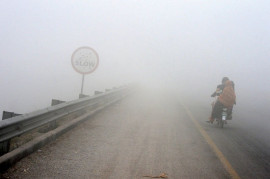Pakistan continues to strive to update its flood warning system on the one hand and to improve its capacity to provide relief to flood victims on the other. What is missing, however, is more tangible information on lessons learnt from the 2010 floods.
This year, the government’s Flood Forecasting Division has predicted that rainfall will be 10 per cent lower as compared to 2010 in those areas of Sindh and Balochistan which were devastated by the floods last year.
At the same time, it has cautioned that the predicted rainfall in Punjab, Khyber- Pakhtunkhwa and parts of Kashmir will be 10 per cent higher.
“The chances of massive flooding cannot be ruled out but river flow will remain normal as compared to last year,” comments the country’s forecast chief, Muhammad Riaz.
Last years floods affected 36 districts and about 20 million people. While comparing river flow in present times with that in the previous year, Riaz said the flow of water was 167,000 cusecs in Tarbela Dam and 200,000 cusecs in Kalabagh. There is no cause for alarm as yet, he added.
Chief Engineer Muhammad Alamgir says that all major rivers - the Indus, Jhelum, Chenab, Ravi and Sutlej are flowing normally, whereas River Kabul at Warsak and River Swat/ Khiali at Munda & Charsadda Road Bridge are flowing in the Low Flood Stage.
But Alamgir confesses that the forecast cells “lack the latest technology to predict ahead of time.”
To address this, the National Disaster Management Authority (NDMA) has formulated a federal level technical working group comprising representatives from the Federal Flood Commission and other bodies, including some UN agencies, to revise the existing contingency plan.
NDMA chairman Dr Zafar Qadir said arrangements have been made for daily updates by telephone for information on water levels in River Chenab at Akhnoor, the River Ravi below Madhupur and the River Sutlej below Rupar, Harike and Ferozepur.
In addition, water outflow from Bhakra Dam on River Sutlej, Pong Dam on River Beas and Ranjit-Sagar (Thein) Dam on River Ravi will be monitored.
Water information will also be broadcast from Radio Jammu three times a day for River Chenab at Akhnoor on discharge of 75,000 cusecs and above, for River Jammu Tawi at Jammu for discharge of 20,000 cusecs and above and River Ravi below Madhupur for discharge of 30,000 cusecs and over.
Qadir also said that from July onwards a flood cell will monitor this information round the clock. But one questions whether this is enough or is the bureaucracy playing tricks again.
Experts say that on occasions, the interaction of easterly and westerly systems may result in heavy downpour causing localised urban or flash flooding. Last year, this had caused much devastation in Sindh and Balochistan.
No one seems to be ready to answer the question of what plan was in place in 2010 and why despite several days notice, Sindh and Balochistan were not prepared for the floods that washed large tracts of land.
For its part, the NDMA wants to blow its trumpet in terms of relief work. Its chief says his organisation had completed relief activities by January, 2011 all over Pakistan except for five most flood affected districts in Sindh and Balochistan where these activities continued till April 15, 2011.
According to the NDMA chairman, 80 per cent work on dykes and dams that were affected in Sindh and Punjab has been completed.
This is important information, given that it was the breaching of dykes and embankments that led to the large scale flooding. No one still knows why Tori Bund gave way. There is still no indication as to who will be held responsible for the poor quality of work that was done on most of these bunds owing to which they succumbed to the pressure of the flood waters.
Now bureaucracy again has its way and funds have poured for repair work. Sindh hopes to complete repair work on embankments of the Indus River, damaged in last year’s floods by mid-July.
In Punjab, the repair work of embankments and spurs is in full swing and has been completed in most places.
In KP, the Provincial Disaster Management Authority based on experiences from 2010, has approved a contingency plan for limiting possible devastation due to monsoon rains.
However, in all this there is no guarantee that the quality of work would be superior to what was done in the past and that greater good and not personal and political interests would be considered when deciding to breach one embankment and not the other.
Published in The Express Tribune, July 14th, 2011.
1734931835-0/Untitled-(81)1734931835-0-405x300.webp)















1734778885-0/Untitled-(10)1734778885-0-270x192.webp)






COMMENTS
Comments are moderated and generally will be posted if they are on-topic and not abusive.
For more information, please see our Comments FAQ